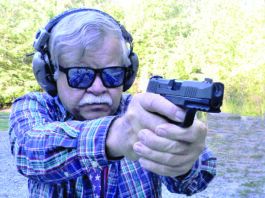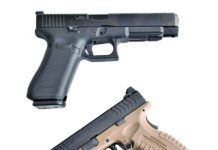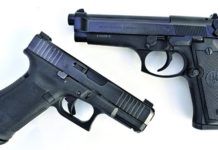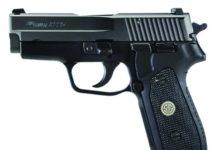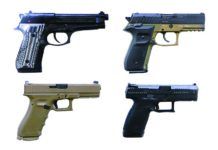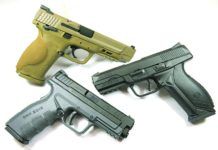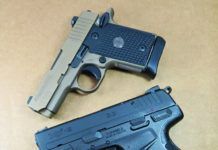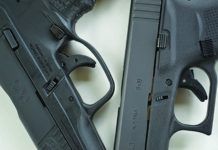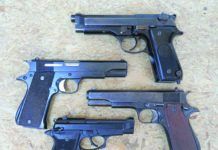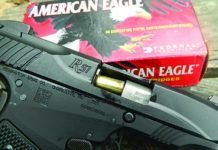VALUE GUIDE: 9MM HANDGUN RANKINGS
VALUE GUIDE: RECENT 9MM HANDGUN RANKINGS
GUN NAME
ISSUE
GRADE
COMMENTS
Springfield XD(M) 4.5 XDMT9459FDEHCE TB 9mm, $505
Apr.
2019
A
Our Pick as a personal-defense, home-
defense, and tactical pistol.
Glock G34 Gen5 MOS PA3430103MOS 9mm, $710
Apr.
2019
A
The Gen5 guns are the best yet, with superior accuracy and features over earlier Glocks.
CZ-USA CZ P0-9 91620
9mm Luger, $402
Apr.
2019
B
Best Buy. CZ has managed to pack a lot of value into the P0-9. 19-round magazine. …
Big 9mm Shootout: Glock, CZ, FN, and Springfield Compete
Handguns are designed to give the user a certain amount of useful power in a portable configuration. For home defense, the limits on "portable" are less restrictive than those for concealed carry under covering garments. Weight is a big issue for carry, but length competes with mass as the dimension that causes the biggest pain in the back. But for performance, length is helpful when it allows for a longer barrel that will make for greater velocity and energy, and up top, a longer slight radius on the slide generally improves accuracy. Also, a longer front end tends to dampen sight movement during recoil, important when chambering a more powerful cartridge such as the 357 SIG. As such, a certain class of handguns — long barrel/long slide models — answer a lot of needs for home-defense shooters, and for the right people, could even be carried. In this report, we looked hard at four 9mm Luger pistols that are among the longest offerings in their respective stables, they were:
- the CZ-USA CZ P0-9 91620 at 8.1 inches in overall length;
- the FNH FNS-9L Longslide 66725 at 8.25 inches OAL;
- the Glock G34 Gen5 MOS PA3430103MOS at 8.74 inches OAL;
- and the Springfield XD(M) 4.5 XD(M)T9459FDEHCE Threaded Barrel, whose 5.3-inch-long barrel contributes to its 8.3-inch OAL.
The CZ P0-9 is a longer version of the CZ P0-7, yet in this group, the barrel is the shortest of the test at 4.54 inches, or 0.79 inch longer than the CZ P0-7's. This pistol also features an elongated grip that holds 19 rounds in the magazine versus 15 for the P0-7. An important difference between this pistol and the smaller P0-7 is that the P0-9 is supplied with interchangeable backstraps. To put it in scale, the well-known CZ 75 B is also 8.1 inches long, but the 75 B is 0.4 inches shorter than the P0-9 and holds three fewer rounds in its magazines. Interestingly, the pistol retails for an average $100 less than the smaller P0-7. This product from Cesk zbrojovka Uhersk Brod is a polymer-framed pistol, but unlike the others tested, the P0-9 is hammer fired. We expected the CZ pistol to handle differently from the striker-fired guns, and it did.
FN America pitches the FNS-9 Longslide as a competition gun (as does Glock for its G34), saying the Longslide has been "tested in every type of major shooting event, from high-speed IPSC/USPSA and grueling 3-gun matches to precision bull's-eye and actions events like the NRA Bianchi Cup." Okay, none of that scares us if we're looking for a dependable, easy-to-shoot self-defense handgun.
The Glock G34 Gen5 is likewise designated as a competition pistol, but it's not Glock's largest 9mm by quite a bit. The G17L Long Slide gets that honor with a 6.02-inch-long barrel and an OAL of 9.53 inches.
Oddly, Springfield's XD(M) 4.5 TB (now discontinued in the two-tone color scheme) is longer than what the company designates as a competition handgun, the 5.25-inch-barrel XD(M)95259BHCE Competition Series 9mm. Despite its nomenclature, the threaded-barrel XD(M) version we test here has a 5.3-inch-long barrel to accommodate the threads and is 0.05 inch longer overall than the 5.25 Model, according to company specs.
Here's what we found out about these longer-than-average handguns.
9mm Striker Gun Shoot-out: Beretta, Glock, and SIG Sauer
To replace the Beretta M9A1 (M9) and later variants in military service, the U.S. Army tested several handguns and chose the SIG P320, which is designated as the M17 in military service. The Glock 19X was also a participant in the military trials. While not chosen by the military, the full-size-grip short-slide Glock has enjoyed commercial success. The new Glock 45 is a direct result of Glock's experience in the military trials and also a result of criticism of the 19X. A third handgun, Beretta's APX, was also not adopted, and like the M17, is a modular design. We elected to test these three striker-fired polymer handguns head to head to determine which might be the best choice for concealed carry and personal defense for civilians. To add some historical texture, we also shot these firearms side by side with a full-size Beretta 92, or the M9 in its military appellation. The Beretta won't carry as easily as the APX and Glock, but it's comparable to the P320-M17 in size. If we're looking at them as home-defense guns, then size is less of an issue.
As we collected data and choose firearms for inclusion in these shoot-outs, we met old-line shooters and even young shooters who feel that the polymer-frame striker-fired market is crowded, and these handguns are much the same. Nothing could be further from the truth. Beretta, CZ, HK, SIG, Smith & Wesson, and Glock offer different features and different fits and feel for their products. Those who have not tested the pistols extensively and who have not taken time to compare features may feel these pistols are cut from the same cloth, but by assuming that, those shooters abrogate a lot of responsibility in choosing the handgun that suits them best.
9mm Slim Line Compact Pistol Shoot-out: Five Go Head To Head
Close in importance to the most basic needs - food, water, and shelter - is the ability to protect yourself from threats. Concealable, compact, and powerful handguns give us peace of mind in a dangerous world. There is no doubt there are more effective cartridges than the 9mm Luger, but the 9mm is far more powerful than any 32 ACP or 380 Auto cartridge, and it holds more rounds than a compact 38 Special revolver. The 9mm is a powerful cartridge with good performance that will get the job done, given adequate shot placement. A compact handgun with good sights, a decent trigger, and ergonomic controls is a stalwart companion in difficult times. So we tested a quintet side by side to get an idea about what we would buy, then relay those impressions to Gun Tests readers. The pistols tested are unique in many ways, but they share a few common features. Takedown, trigger action, and slide-lock designs differ. Each may fit your needs more than the others, but there are a couple at the top of the heap. Our test handguns chambered in 9mm Luger were the following.
Problems with SIGs P320
We recently published a news item that updates our readers on legal troubles the SIG Sauer P320 is encountering. Most recently, the Loudoun Times-Mirror website is reporting that a Loudoun County (Virginia) deputy has filed a lawsuit against SIG Sauer alleging that her fully-holstered P320 duty weapon discharged and sent a bullet into her leg. According to the newspaper's account, the incident occurred this year on Feb. 7, "… when 37-year-old Loudoun County Deputy Marcie Vadnais went to the Northern Virginia Criminal Justice Academy to attend a general instructor course." The Times-Mirror further reported, "In accordance with academy policy, Deputy Vadnais began removing her firearm from her belt when she arrived." According to the lawsuit, as she fed the belt through the holster's first tooth, her SIG Sauer P320 somehow "fired one nine millimeter bullet, which hit her in the upper right thigh."
Personal-Defense 9mm Handgun Shoot Out: Smiths M2.0 Wins
The most popular concealed-carry and home-defense handgun in America is likely the 9mm self loader. There are service grade and service-size pistols, compacts, and subcompacts available in this chambering, which has gained popularity because of improved bullet function. In this installment, we are firing purpose-designed compact handguns that are derived from service-size handguns. When the Glock 19X was introduced, with its Glock 17 grip and Glock 19 slide, our shooters knew it would be a hot new gun to test, but we did not quite know what to match against it. The editor dubbed it a Commander-size Glock 9mm, so we found a 9mm 1911 Commander to brace against it — the Ruger SR1911 Commander. The SR1911 Commander is, after all, a full-size Government Model pistol with the slide shortened three-quarters of an inch. The Glock 19X is a Glock 17 with a short slide and full-size grip. Bingo.
European compacts generally have both the slide and the butt shortened. One example is the SIG P225A, a short version of the SIG P220 9mm handgun. Today, SIG offers an updated and revamped P225-A1. We added this double-action-first-shot pistol as a counterpoint to the double-action-only and single-action pistols tested. Next, we added a true compact with both a short slide and short frame, the Smith & Wesson M&P9 Compact M2.0. It seemed fitting to match the M2.0 M&P9 against the Glock 19X Gen5 gun.
Service-Sized 9mm Handguns Shoot It Out for Carry Honors
We recently tested a quartet of 9mm-chambered full-size firearms suitable for daily carry: the Lipsey's Glock 17RTF2 Vickers FDE based on the Glock 17, a Beretta 92FS with Wilson Combat upgrades, an Arex Rex Zero 1 Standard, and a CZ-USA CZ P-10 C. Each one could be thrown into any mix of handguns and do well. But there are specific differences that will make one pistol or another preferable for an individual, and that is what this shoot out is all about.
Full-size 9mm handguns have an impressive reserve of ammunition, they handle recoil well, and offer real power with +P loads. For home defense, a 14- to 18-shot 9mm handgun is effective, perhaps the best all-round home-defense handgun for a trained shooter. In this test, each pistol is an example of a popular carry gun as well, with many shooters concealing a Glock 17 or even a Beretta 92FS for daily carry. Here, all had faultless reliability, which is a prerequisite for a defense firearm in our testing. We also learned the Lipsey's/Vickers Glock gave excellent results on the combat course, and the Wilson Combat-upgraded Beretta aced the field in accuracy. We trust these pistols, but only one was the best performer overall for our shooters. For certain preferences and duties, each has advantages, which we note in detail below.
All handguns tested for personal defense must be proven on the firing range. We tested two examples of upgraded service pistols. A special-run RTF texture Glock 17 from distributor Lipsey's has a Vickers Tactical package added to it, with components suggested by or supplied by well-known trainer Larry Vickers. Likewise, we tested a Beretta 92FS updated with Wilson Combat parts. The results for both are better range performance, especially when performing rapid magazine changes because each package features a magazine guide and magazine base pads.
We matched the Glock and Beretta against the new CZ P-10 C, a polymer-frame striker-fired pistol, and the Arex Rex Zero 1 Standard, which is considered by some to be an improvement over the SIG P226 9mm handgun. We had a mix of two double-action-only polymer-frame striker-fired pistols, a double-action-first-shot pistol with a decocker, and a selective-double-action pistol with decocker.
In the end, the Glock's highly advanced sights provided excellent results on the combat course. Perhaps the RTF frame was another plus. The Beretta 92 provided exceptional accuracy, which we felt was due to the improved trigger action. The CZ is an affordable and reliable handgun, and the Rex Zero is a good example of European craftsmanship. All in, it was hard to isolate a winner among these top-flight handguns with good performance. We think that most shooters will find the Glock 17 to be the best overall handgun for personal defense and home defense. Just the same, the CZ P-10 C is a good buy. Those seeking top-flight accuracy will find the Beretta to be a good fit. The Rex Zero has a quirk we did not like regarding reach to the magazine release, but the Arex is a good performer for some shooters, outperforming the Beretta in combat shooting. As usual, the devil is in the details, so here we go.
Size 9mm Striker-Fires From Ruger, S&W, Springfield
We live in a polymer-frame, striker-fire, double-stack world. At first glance, most of these types of pistols seem to offer the same features, so what separates these pistols aside from price point and manufacturer? A lot, we found out. We chose three recently introduced 9mm models for testing. The first was the Ruger American Pro Duty, which is Ruger's new full-size striker-fire pistol with a modular grip. The second was the next evolution of the Springfield Armory XD series, the XD MOD.2 4-Inch Service, which wears SA's GripZone texture in the grip. We previously tested the compact XD MOD.2 3.3-inch models in both 9mm and 45 ACP and gave them an A rating. The third 9mm striker fire was the new M&P9 M2.0 from Smith & Wesson. We tested S&W's first generation of M&P9 models and found they rated from A to B+, depending on the model. All three pistols are striker-firers, use a polymer receiver/frame, are chambered in 9mm, have double-stack magazines, and are full-size pistols.
For range testing, we used a combination of hollow-point and full-metal-jacket bullets in different bullet weights. Our four test loads consisted of Hornady American Gunner, loaded with a 115-grain XTP bullet, a SIG Sauer 115-grain full-metal-jacket (FMJ) bullet, Liberty Ammunition Civil Defense's 50-grain hollow-point bullet, and Aguila's 124-grain FMJ load. We tested accuracy at 25 yards using a rest, then moved the target to 15 yards for speed shooting and reload manipulations. We were paying close attention to accuracy, ease of use, reliability and consistency. As the brass cooled, here's what we learned.
Micro 9mm Pistols From Kimber, Springfield Armory, and SIG
We've received emails specifically requesting we review the Kimber Micro 9 and SIG P938. Readers wrote that they "like the idea ofguns made out of actual metal that operate in a very similar manner to a M1911." So we obliged and assembled a pair of 1911 micro-9mm pistols, a Kimber Micro 9 Desert Tan (LG) with laser grip and a SIG Emperor Scorpion P938. We also added to the mix a new polymer-frame 9mm with a DA/SA trigger, the Springfield Armory XD-E. It is not a 1911 platform at all, but the XD-E is a pistol in the same size class as the Kimber and SIG. All are chambered in 9mm Luger, have barrels that measure from 3- to 3.3-inches in length, employ single-stack magazines, and are designed for concealed carry.
For speed testing, we performed the Bill Drill at 7 yards firing a magazine as fast as we could while still keeping hits in an 8-inch circle. The intent with this drill is to improve speed without eroding accuracy. It also helps us run the pistol dry, check for slide lock back, perform numerous magazine changes, and repeatedly use the slide release as well as test rapid sight alignment and trigger press. We start at the low ready position. All three pistols performed reliably and consistently.
The micro 1911s look similar to a 1911 pistol, but the operating systems are quite different. The Kimber and SIG 1911s are scaled down for conceal carry and have 1911 design elements such as the controls, single-action triggers, and grip angle to create a true back-up-sized 1911. If you are familiar with a 1911, then the transition to one of these micro 1911s will be seamless. The thumb safety, slide release, and magazine release are just like those in the 1911 design. These mini 9mm pistols disassemble with ease, so maintenance is not a chore. We found we liked the mini 1911s in 9mm, and the vote was evenly split between the SIG and Kimber.
The XD-E is an entirely new beast that one tester said looks like a DA/SA trigger mechanism placed in an XD-S receiver mated to a MOD.2 slide. Maybe that's how it got drawn on a cocktail napkin? Who knows. Our team thought the XD-E needed a few tweaks, though it proved to be a capable shooter. Here are the details on all three.
Compact 9mms from Glock, Honor Defense, S&W, Walther
Our retailer friends tell us that the most popular carry gun in America is the compact 9mm self-loading pistol with a single-column magazine. These handguns are handy, concealable, and powerful enough for personal defense. They deliver acceptable ballistics without harsh recoil and are affordable. Most are based on service-size handguns. The engineering in downsizing the pistols has been faultless in many, but not all, renditions, so everyone wants to know if Compact Pistol "A" is as reliable for practical use as any full-size pistol. And if Compact Pistol "A" is that reliable, it makes it easier to narrow down the many choices to the best choice for you. We get a lot of questions about such handguns, and this lineup includes four handguns readers have asked us to test.
The Smith & Wesson and the Glock are based on service guns, while the Honor Defense Honor Guard and Walther PPS are purpose-designed compacts with no service-sized big brother.
When we first tested the Glock 43 Subcompact Slimline G43 two years ago (August 2015), it earned a B+ in our evaluation when it was paired with the Walther CCP head to head. In that evaluation, we noticed that the slide was narrow and nicely beveled. Glock did not simply stick a Glock 19 slide on a slim frame. The locked-breech operating system and trigger action are preserved. Anyone owning a Glock of any size or frame will be able to use this handgun in the same manner because the action is identical to all other Glock pistols. The sights were standard Glock, with a white outline rear and white dot forward, the same as the test gun this round. They proved adequate for combat firing and were reasonably good for accuracy work at 15 yards. We also noted then that there is a shelf under the slide on the frame that protects the slide lock from a finger contacting the slide lock during recoil. It is common for the support-hand thumb to bump the slide lock and lock the slide to the rear when firing a hard-kicking compact. The shelf seems to eliminate this problem, then and now. Also, the Glock frame does not incorporate a light rail for a combat light.
In both guns, the Glocks featured a spring-within-a-spring guide rod that we feel does an excellent job of containing recoil. Once on target, however, the Glock was handicapped by a 6.75-pound trigger pull. This time around, the G43's pull was more than a pound lighter. Two years ago, we also noted that due to its polygonal rifling, you should rule out lead-bullet handloads.
In November 2016, we looked at a specialized version of the gun, a Glock G43 Limited Edition ProGlo TALO Edition UI4350501. TALO is a wholesale buying cooperative that creates special edition firearms, which have to be ordered from a local dealer. On this Glock 43, the pistol's slide was standard save for the sights, which were made by AmeriGlo and featured a brilliant orange post around a white-insert tritium front. The rear sight featured a U-notch for rapid target engagement, and the rear face of the rear sight was serrated to reduce glare. Even with these upgrades, we gave the Glock a B grade.
Our only time to have tested an S&W M&P9 Shield 9mm Luger was in the March 2013 issue, so this update is overdue for a handgun that so many people seem to like. Four years ago, we called it a pleasant, compact, slim, nicely made handgun. Then, as now, we said it was easy enough to get it into a pocket of reasonable dimensions. There was nothing sticking out of the Shield to get caught on clothing. The magazines were easy to get out and back into the gun. They had a somewhat staggered design that made them more compact for their capacity. The gun was matte black with semi-slick pebbly inserts on front and rear of the grip straps.
The Shield had an external safety on its left side. The sights were excellent, dovetailed into the slide, and tritium is an option. The rear was secured with a screw so you could adjust the windage. The front was held solely by friction in the dovetail. The trigger pull was heavy and consistent at about 7.5 pounds, and the trigger rebound was short.
Takedown required locking the slide back and applying manly force to the takedown lever to rotate it 90 degrees. Then the slide could be let down to its normal position, the trigger pulled, and the slide comes off the front. Removing the captive double recoil spring was extremely easy. There's no danger of parts flying across the room, or losing an eye when you put it all back together. We noted a significant fillet on the hook of the S&W's extractor. It also had a slight pocket to help catch the incoming rounds as they feed from mag to chamber. The striker-locking safety plunger inside the slide is cammed upward by the trigger arm, which actively forces the plunger out of the way.
Surplus 9mm Pistols From Star and Beretta: Worth the Cash?
The idea of what constitutes a "surplus firearm" has different meanings depending where you are in the world. Surplus firearms in the U.S. means extra on hand or dated equipment. In other countries, it could mean one step away from scrap metal. We try to avoid the latter, but we are always on the lookout for a diamond in the rough, and thought we'd look at a few surplus 9mm Luger and 9mm Kurz (380 Auto) pistols. We wanted to look at these pistols through the lens of an inexpensive pistol that would be suited as a sand pit plinker, but in a pinch, it perhaps could be called on to defend the ranch. The problem with older surplus pistols is the lack or scarcity of spare parts, including magazines. By definition, all surplus weapons have been used, and some used more than others.
We chose four pistols that are fairly common and easy to find online to go bargain hunting: Two are Berettas, a Model 92S and Model 85F, made in Italy by P. Beretta S.P.A., and two are Star pistols, made in Spain by Star Bonifacio Echeverria, S.A., a Model Super B and Model B. The Star Model Super B looks like it is ready for the scrap yard and the older Model B looked well used, but as we found out, both still had some teeth. The Beretta 92S is a second-generation 92, which evolved into the 92FS. The 92S is a lot more of a European gun than the 92FS, which definitely has US influence. The Beretta 85F is a smaller version of the 92FS and is the most modern of the pistols tested.
In past issues we have tested some old-school combat pistols and found them lacking, which makes sense. A horse worked a century and a half ago; but now we (can) drive Hummers. Accordingly, we had to make some accommodations for these guns' age. Since these are older pistols, we did not test with proofing loads or +P+ loads. These pistols were not designed for that type of high-pressure ammunition, and we had no desire to taste Italian or Spanish steel. Not that we are implying these are substandard pistols. These pistols are safe when used with ammunition originally intended for them. What we did want to find out was if different bullets types would impact performance. For instance, the Star pistols were manufactured before hollow-point bullets were popular, and we figured they might choke on hollow-point ammunition. We also wanted to see if different bullet weights would cause a stovepipe jam or failure to eject. We used off-the-shelf 9mm Luger ammo consisting of Hornady American Gunner with 115-grain XTP jacketed hollow points ($47/75 rounds), Aguila 124-grain FMJs ($17/50), and SIG Sauer 115-grain FMJ ($18/50). We found all three ammo types cycled flawlessly through the pistols with no issues. In the Beretta 85F, we fired 91-grain FMJs from Tula, 90-grain Speer Gold Dot hollow points, and Hornady Critical Defense 90-grain XTPs, which feature a hollow-point bullet with a polymer insert to facilitate expansion.
For accuracy testing, we placed the pistols on a bench rest to fire at targets set at 25 yards. In speed-firing exercises, we shot at targets at 7 yards, performing both Bill Drills and Mozambique Drills. The object with the Bill Drill is to fire as fast and as accurately as possible to hit an 8-inch zone. The Mozambique requires two fast shots to center of mass and a one to the head. All must be within their zones to be successful. This is what we found out when we exercised these old pistols.
The Return of Remingtons R51 Semi-Auto: How Does It Fare?
We recently tested four single-stack 9mm Luger defense-oriented handguns, among the most popular carry guns in America. Three were single-action pistols and one was a double-action-only model. The spread in expense was pronounced, from less than $200 to more than $700. As always, when we're evaluating carry pistols, handling and accuracy mean a lot, but reliability is the bottom line, and we start with a pistol that has had a mark beside its name for being unreliable. In the lineup was a pistol taking its second bite at the apple, Remington's R51 96430 9mm Luger, which has undergone a recall and revamp and is now back on dealer shelves. Pitted against it were a SIG Sauer P938 Engraved Rosewood Micro-Compact 938-9-ESR, a Taurus 709 Slim 1-709031FS, and a Kel-Tec PF-9.
All of these handguns have a history with us. Most recently, the R51 did well in its initial test in our pages, but was recalled shortly thereafter. In the August 2014 issue, we said, "The Remington R51 was a handy, comfortable pistol of just the right size for its power. Felt recoil with the hottest ammo was amazingly light, and muzzle flip was almost non-existent. It had an odd takedown procedure that was easily mastered. The gun had enough accuracy for its intended purpose. It worked well, was not too expensive, had a great trigger and great sights, and we really liked the concept.
"Though our FFL advised us that other shooters were having function problems with the R51, our test gun simply did not exhibit those problems. Because we only report what happens in our tests and base our grades on our own experiences, we could not fault the R51 for issues other people were having.
"However, after publication of the August print issue, we learned that the R51 had been recalled by Remington. We adjusted the grade on the R51 to an F and returned our test gun to the factory under the recall program."
Then, late last year, Remington Arms Company announced that the R51 had returned to the market with enhancements that included updated slide internals, precision-engineered extractor, locking snag-free sights, tuned recoil spring, hard-chromed barrel bushing, a single-action trigger, and two semi-flush 7+1 round magazines. At the time of the re-release, Remington said the pistol had been extensively tested. The company again touted the R51's features and benefits, including a lightweight aluminum frame with rounded edges for comfortable conceal carry, a grip safety, low bore axis for reduced recoil/muzzle flip, a concealed carry trigger that was a light, crisp single action, low slide racking-force for ease of manipulation, an ambidextrous magazine release, locking drift-adjustable sights, and optimized grip angle. Our test gun, a full replacement of the original, has a suggested retail price of $448.
The last time we looked at the Kel-Tec PF-9 9mm was in April 2011. Of the PF-9, we said, "All business-like flat black, the blued Kel-Tec PF-9 is slim and easily concealable. It was a bit too big for most trouser pockets, but would fit most overcoat pockets. The fixed sights gave an excellent picture that we thought could be improved by widening the rear notch. There were three white dots. The rear sight was adjustable for windage, and by shimming for elevation. An Allen screw secured it. Both the front and rear sights were polymer, as was the trigger and, of course, most of the frame.
"The integral grips had a coarse checkerboard pattern that provided excellent traction, and the front and rear grip straps had vertical serrations. The magazine release was a steel button that was not easy to hit accidentally, but let the mag come out easily when intentionally pressed. The gun could be fired with the magazine removed.
"In our testing we came to love the trigger of the Kel-Tec. We had no trouble whatsoever with short-stroking the trigger in rapid shooting. In fact, the recoil seemed to blow the gun backwards and our trigger finger forward. We were unaware of the trigger needing to be carefully allowed to go all the way forward. We essentially had no problems at all with the Kel-Tec PF-9. We had one failure for the slide to lock back on empty with the first magazine-full through it, but that never happened again. We think this is one mighty fine 9mm handgun, but it is not for the recoil-sensitive person."
About a year later (March 2012) we test-fired the Taurus 709B Slim No. 1-709031. Back then, we said of the handgun, "We never suffered a failure to ignite or any other type of malfunction, so all shots in our tests were performed using the single-action trigger. From the 10-yard bench, only two groups measured 2 inches wide or larger. Overall average size for all groups fired in our tests computed to about 1.5 inches.




























